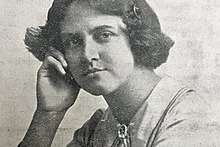Marjorie Hasler
Marjorie Hasler (c.1887 – 31 March 1913) was an Irish suffragette, deemed to be "the first Irish martyr for the suffragette cause".[1][2][3]
Marjorie Hasler | |
|---|---|
 | |
| Born | c.1887 |
| Died | 31 March 1913 (aged 25–26) |
| Nationality | Irish |
| Known for | Activism as a suffragette |
Biography
Marjorie Hasler was born around 1887 in Ireland, with nothing else known about her early life or family. She joined the Irish Women's Franchise League (IWFL) in July 1910. On 18 November 1910 Hasler was one of the Irish deputies who travelled to London to support Emmeline Pankhurst with her petition to H. H. Asquith, the British Prime Minister. In the ensuing violence of this day, which became known as "Black Friday", Hasler suffered a head injury when she was knocked against a wall. As a result she suffered headaches intermittently, as well as some damage to her spine. This did not dissuade Hasler from her militant action, returning to London the next year when she was imprisoned for 14 days for breaking government windows.[1][4]
In June 1912, Hasler was imprisoned with Hanna Sheehy-Skeffington and 6 other women in Mountjoy Prison for her part in breaking the windows of the General Post Office, Dublin. These 8 women were the first to be convicted and imprisoned in Ireland for militant suffragette action.[5] She was fined £10 and sentenced to 6 months, which was the longest sentence of any of the 8 convicted suffragists. Hasler compared suffragists to Land Leaguers in an article for The Irish Citizen on 22 June 1912: "We don't like smashing windows any more than men like smashing skulls, but in both cases there is, I believe, a strong feeling that something must be broken before a wrong can be righted." She was released on 10 November 1912 after serving 4 months following the submission of a petition signed by 10 of the jurymen who convicted her. Sheehy-Skeffington claimed that Hasler refused to let the IWFL to also petition on her behalf.[1][6]

Upon leaving prison, Hasler's health was damaged, however this is in contrast to Sheehy-Skeffington's testimony of Hasler's athletic stunts whilst in prison. Hasler died suddenly on 31 March 1913 after contracting measles. Her death has been described as from heart failure. Her fellow suffragists and The Irish Citizen maintained that it was her imprisonment and police brutality that had damaged her health in the year proceeding her death. Sheehy-Skeffington described her as "singularly beautiful, her face clear-cut as a cameo, with flashing brown eyes, framed in short brown curls."[1][2]
References
- Hourican, Bridget (2009). "Hasler, Marjorie". In McGuire, James; Quinn, James (eds.). Dictionary of Irish Biography. Cambridge: Cambridge University Press.
- Reynolds, Paige (2007). Modernism, Drama, and the Audience for Irish Spectacle. Cambridge: Cambridge University Press. pp. 104-105. ISBN 0521872995.
- Steele, Karen Margaret (2007). Women, Press, and Politics During the Irish Revival. New York: Syracuse University Press. p. 24. ISBN 0815631170.
- "Marjorie Hasler: A Suffragist Martyr | Dublin City Council". Dublin City Libraries. Retrieved 15 July 2018.
- Crozier-De Rosa, Sharon (2017). Shame and the Anti-Feminist Backlash: Britain, Ireland and Australia, 1890-1920. Routledge. ISBN 1136200738.
- Atkinson, Diane (2008). Rise Up Women!: The Remarkable Lives of the Suffragettes. London: Bloomsbury Publishing. ISBN 9781408844069.